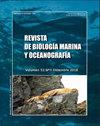在金鱼Seriola lalandi(鲈形目:Carangidae)养殖废水中培养的小球藻(Trebouxiophycea,绿藻)的生长和生物修复能力
IF 0.5
4区 生物学
Q4 MARINE & FRESHWATER BIOLOGY
引用次数: 9
摘要
在实验室规模条件下,研究了微藻小球藻的生长及其对黄尾鱼孵化场废水中溶解营养物质的去除效果。本研究采用过滤和紫外线消毒的出水,接种初始浓度为2.06·10 6±4.16·10 3个细胞的小球藻mL-1,对8天的室内外条件进行了评价。在生长和养分去除的测定中,使用了12个容量为50L的透明圆柱形锥形池塘。每个实验条件下使用三个池塘,室内(3)和室外(3),用多拉培养物的出水,其余六个池塘分别在室内(3和3)使用1μm过滤海水进行对照,用普通培养基F/2消毒和富集。在室内条件下的生长结果在6天后达到最大值4.17·10 6±7.57·10 5细胞mL-1。在对照罐中获得了类似的生长4.75·10 6±2.29·10 5个细胞mL-1,而在室外实验条件下,第2天获得的最大生长为2.81·10 6士2.69·10 0 5个细胞mL-1,与显示最大生长为1.83·10 7±2.29·10 5个胞体mL-1的对照相比。记录的亚硝酸盐去除效果最好,分别为91.67%和88.41%(室内和室外条件)。在两种实验条件下,硝酸盐的去除率分别达到57.47%(室内)和29.31%(室外),氨的去除率相似,为42.22%。最后,观察到65.78%(室内)和75.78%(室外)的高磷酸盐去除率。结果表明,利用微藻小球藻吸收废水中的营养物质和生长是可行的,这为其在养鱼活动或产生具有这些特征的废水的其他行业的净化过程中的应用开辟了令人鼓舞的前景。本文章由计算机程序翻译,如有差异,请以英文原文为准。
Crecimiento y capacidad de biorremediación de Chlorella vulgaris (Trebouxiophycea, Chlorophyta) cultivada en aguas residuales generadas en el cultivo del pez dorado Seriola lalandi (Perciformes: Carangidae)
Growth of microalgae Chlorella vulgaris and its efficiency in dissolved nutrients removal from effluent generated by yellowtail amberjack hatchery production were studied under laboratory scale conditions. This research evaluated indoor and outdoor conditions during 8 days, using filtered and UV light disinfected effluent, inoculated with an initial concentration of 2.06·10 6 ± 4.16·10 3 cells mL -1 of Chlorella vulgaris . In the determination of the growth and removal of nutrients, 12 transparent cylindrical-conical ponds with a capacity of 50 L were used. Three ponds were used for each experimental condition, indoor (3) and outdoor (3), with effluent water from the dorado culture, the remaining six ponds were controls using 1μm filtered seawater, disinfected and enriched with general culture medium F/2, in indoor (3) and outdoor (3), respectively. The result of growth under indoor condition reached a maximum value of 4.17·10 6 ± 7.57·10 5 cells mL -1 after 6 days. Similar growth was achieved in control tanks 4.75·10 6 ± 2.29·10 5 cells mL -1 , whereas in outdoor experimental condition the maximum growth obtained was 2.81·10 6 ± 2.69·10 5 cells mL -1 reached on day 2, compared with controls that showed a maximum growth of 1.83·10 7 ± 2.29·10 5 cells mL -1 . The best nutrient removal results recorded as nitrite removal were values of 91.67 and 88.41% (indoor and outdoor conditions, respectively). Nitrate removed reach a 57.47% (indoor) and 29.31% (outdoor) and a similar ammonia removal of 42.22% for both experimental conditions. Finally, high phosphate removal of 65.78% (indoor) and 75.78% (outdoor) were observed. The results show that the use of the microalga Chlorella vulgaris for the absorption of nutrients and growth in wastewater is feasible, which opens up encouraging perspectives for its application in purification processes in the fish farming activity or another industry that generates effluents with these characteristics.
求助全文
通过发布文献求助,成功后即可免费获取论文全文。
去求助
来源期刊
CiteScore
0.70
自引率
0.00%
发文量
41
审稿时长
12 months
期刊介绍:
Publicar desde una perspectiva científica, artículos originales, decididos por un proceso de revisión por pares, invitando a expertos de reconocido prestigio en el área. Los trabajos publicados se caracterizarán por su solidez teórica-metodológica, actualidad y relevancia para las ciencias marinas.
Se reciben trabajos inéditos derivados de la investigación científica realizada en ambientes marinos y estuarios, en formato de Revisión, Artículos, Notas Científicas, y Obituarios en las siguientes disciplinas::
Biología-Ecología marina
Oceanografía física, química y biológica
Contaminación marina
Geología marina
Sistemática, Faunística y Biogeografía Marina
Manejo Costero
Acuicultura marina
Pesquería marina.

 求助内容:
求助内容: 应助结果提醒方式:
应助结果提醒方式:


